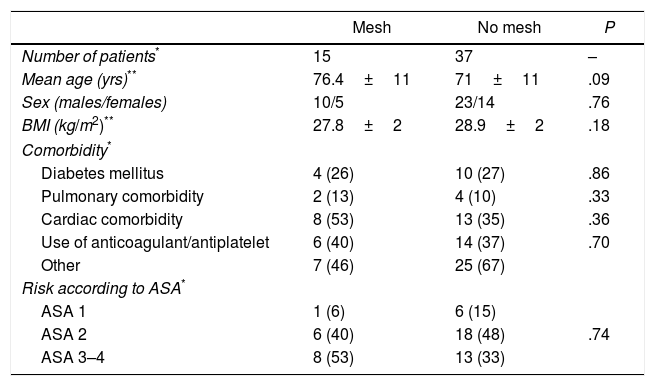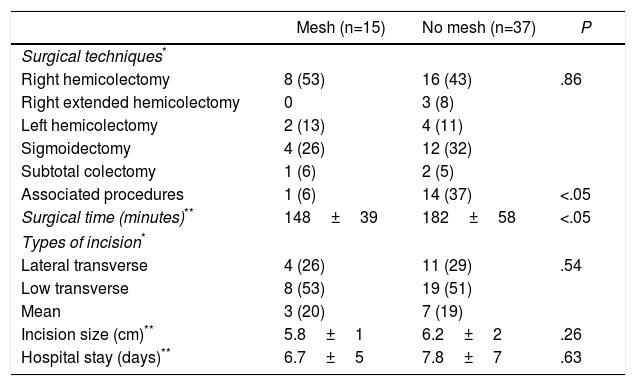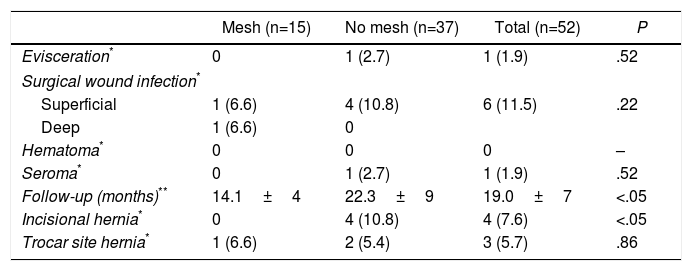The rate of incisional hernia in high-risk patients (obesity, cancer, etc.) is high, even in laparoscopic surgery. The aim of this study is to evaluate the safety of the use of cyanoacrylate fixed prophylactic meshes in the assistance incision in overweight or obese patients undergoing laparoscopic colorectal surgery.
MethodsA prospective, non-randomized cohort study of patients undergoing elective laparoscopic resection for colorectal cancer between January 2013 and March 2016 was performed. Those with a body mass index greater than 25kg/m2 were evaluated to implant a prophylactic meshes fixed with cyanoacrylate (Histoacryl®) as reinforcement of the assistance incision.
Results52 patients were analyzed (mean body mass index: 28.4±2kg/m2). Prophylactic meshes were implanted in 15 patients. The time to put the mesh in place was always less than 5min. There was no significant difference in wound infection rate (12% vs 10%). No mesh had to be explanted. Although the mean follow-up was shorter (14.1±4 vs 22.3±9 months), there were no incisional hernia in the mesh group. On the other hand, in the non-mesh group, 1 acute evisceration (2.7%) and 4 incisional hernia of the assistance incision were observed (10.8%). There were no significant differences between groups regarding trocar incisional hernia (6.6% vs 5.4%).
ConclusionsThe implantation of a reinforcement prophylactic mesh in overweight or obese patients undergoing laparoscopic colorectal surgery is safe and seems to reduce the short-term rate of incisional hernia. Fixation with cyanoacrylate is a rapid method that facilitates the procedure without additional complications.
La incidencia de hernia incisional en pacientes de riesgo (obesidad, cáncer, etc.) es elevada, incluso en cirugía laparoscópica. El objetivo de este estudio es evaluar la seguridad del empleo de mallas profilácticas retrofasciales fijadas con cianoacrilato en la incisión de asistencia en pacientes con sobrepeso sometidos a cirugía laparoscópica colorrectal.
MétodosEstudio prospectivo de cohortes, no aleatorizado, de pacientes sometidos a resección laparoscópica electiva por cáncer colorrectal entre enero de 2013 y marzo de 2016. Aquellos con índice de masa corporal superior a 25kg/m2 fueron evaluados para implantar una malla profiláctica fijada con cianoacrilato (Histoacryl®) como refuerzo de la incisión de asistencia.
ResultadosSe analizan 52 pacientes (índice de masa corporal medio: 28,4±2kg/m2). En 15 pacientes se implantó una malla profiláctica. El tiempo de implante siempre fue inferior a 5 minutos. No hubo diferencias significativas en la tasa de infección de herida (12 vs 10%). Ninguna malla requirió ser explantada. Aunque el seguimiento medio es menor (14,1±4 vs 22,3±9 meses), no ha aparecido hernia incisional en el grupo malla. Por el contrario, en el grupo no malla se han observado una evisceración (2,7%) y 4 eventraciones de la incisión de asistencia (10,8%). No hubo diferencias significativas entre los grupos respecto a hernia incisional de trócar (6,6 vs 5,4%).
ConclusionesLa implantación de mallas profilácticas en pacientes con sobrepeso u obesidad sometidos a cirugía laparoscópica colorrectal es segura y parece reducir la tasa de eventraciones a corto plazo. La fijación con cianoacrilato es un método rápido que facilita el procedimiento sin complicaciones adicionales.













